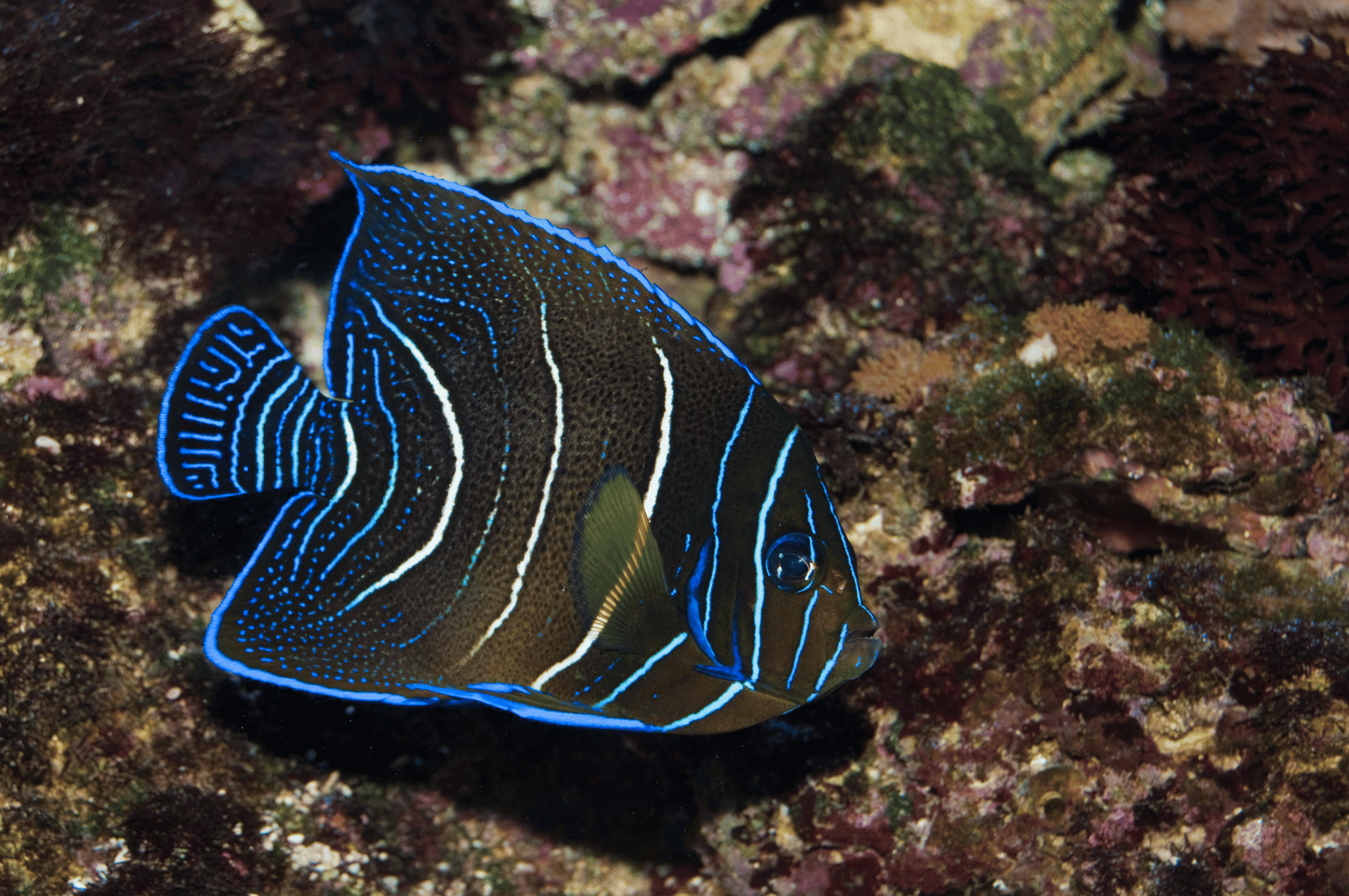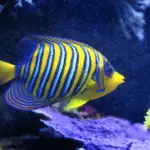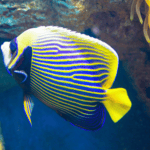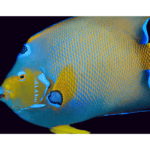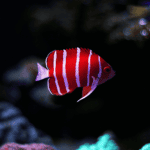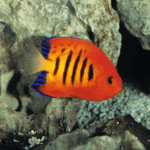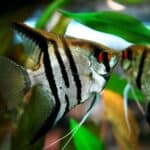The Koran Angelfish, scientifically known as Pomacanthus semicirculatus, is a captivating marine species cherished by aquarists for its striking appearance and dynamic personality. As a member of the marine angelfish family, it boasts a unique combination of colors and patterns that evolve from juvenile to adulthood, marking it as a visual highlight in any marine aquarium environment.
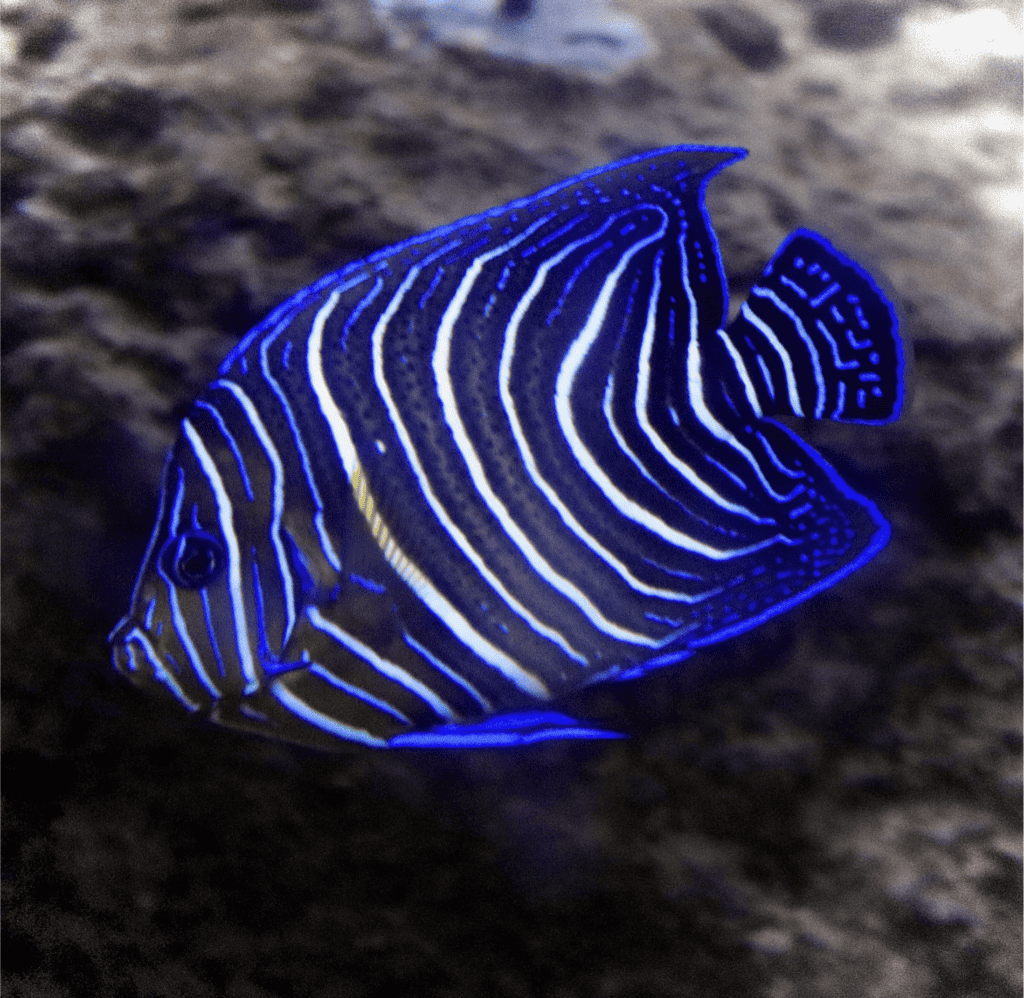
Natural environments for the Koran Angelfish are typically coral reefs and lagoons in the Indo-Pacific region, where they lead a semi-nomadic life grazing on a variety of sponges, tunicates, and algae. Adaptations to such a diet and habitat are evident in the species’ morphology and behavior. In home aquariums, owners must endeavor to replicate their natural conditions as closely as possible to ensure their well-being, which includes managing water quality and providing a diet that sustains healthy growth and coloration.
When considering the Koran Angelfish for a marine aquarium, it is essential to understand their social behavior and compatibility with other tank inhabitants. They can grow to a considerable size, which necessitates a spacious tank, and their semi-aggressive nature requires thoughtful selection of tank mates. While they are not the easiest species to breed in captivity, under the right circumstances, successful reproduction is possible, contributing to the growing knowledge about their lifecycles and behaviors.
Key Takeaways
- The Koran Angelfish is a visually appealing species that transitions in color and pattern from juvenile to adult stages.
- Providing an environment similar to their natural coral reef habitat is crucial for their health and longevity in an aquarium.
- Understanding the species’ dietary needs, growth potential, social behavior, and compatibility is key for a successful aquarist experience.
Natural Habitat and Distribution
In our exploration of the Koran Angelfish, it is noted that these fish thrive in specific marine conditions that are vital for their survival and distribution. They are primarily found in the Indo-Pacific region.
Geographic Range
The Koran Angelfish, scientifically known as Pomacanthus semicirculatus, has a wide geographic range. Their presence spans Indonesia to Samoa, reaching as far north as southern Japan and as far south as Western Australia. They are also inhabitants of the Red Sea. These fish are commonly located in these tropical waters, highlighting their preference for warmer sea temperatures.
Habitat Requirements
Koran Angelfish are saltwater species that favor coral reefs as their natural habitat. The reefs provide both shelter and feeding grounds. These areas are rich in biodiversity, which supports a healthy diet for the angelfish. They are known to adapt well to reef aquariums if the following water parameters are carefully maintained:
- Specific Gravity: 1.020 – 1.025
- Temperature: 72 – 82°F (22 – 28°C)
- pH: 8.1 – 8.4
- dKH: 8 – 12
Our understanding of the Koran Angelfish’s habitat requirements is essential for both their conservation in the wild and their care in aquarium settings. Maintaining these parameters is crucial for simulating their natural environment and encouraging thriving populations.
Physical Characteristics
We begin by focusing on the key elements of the Koran Angelfish’s appearance, which change significantly from juvenile to adult stages. Coloration, patterns, and size are among the distinctive traits that make this species easily recognizable.
Juvenile Appearance
When young, the Koran Angelfish displays a strikingly different pattern compared to adults. Juveniles have a deep blue to black body with electric blue and white concentric curved stripes that dazzle observers. Their body shape is more rounded, and they are generally smaller, measuring up to 13cm (5 inches) in length.
Adult Morphology
As adults, Koran Angelfish mature into laterally compressed, deep-bodied fish. They exhibit a pronounced nape with a steeply angled forehead. Adult size is considerably larger than juveniles, reaching an impressive 40cm (15.7 inches) in diameter – a detail that aquarists and enthusiasts must consider when providing adequate space for these angelfish.
Coloration and Patterns
Our Koran Angelfish possesses dynamic coloration and patterns across its life stages. Adults have a primarily yellow-green hue overall, with a subtle blue sheen over the scales and darker anal and dorsal fin edges. Particularly notable are the sapphire-blue gill margins that add a striking contrast. This species also features a distinctive white ring near its tail, characteristic of the ‘Half-circle Angelfish‘ – another common name for the species due to this pattern.
Care and Maintenance
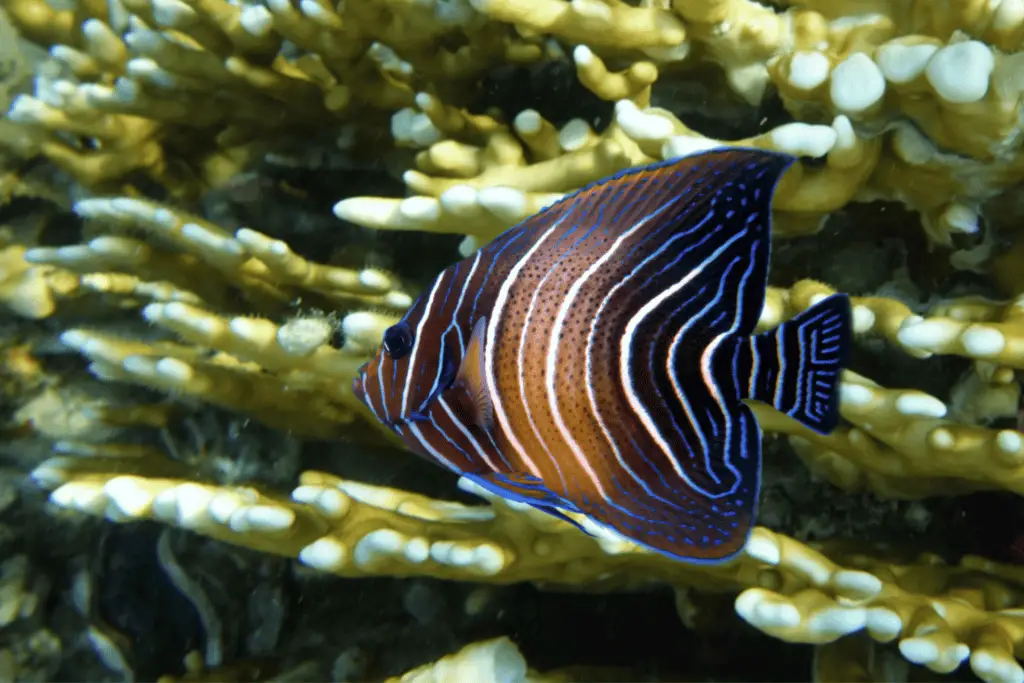
In keeping Koran Angelfish healthy and thriving, we must prioritize their specific aquarium needs, adhere to a nutritious diet, and prevent diseases through vigilant care.
Aquarium Requirements
The Koran Angelfish requires a spacious and well-established aquarium to thrive. We recommend a minimum tank size of 125 gallons, as this allows the fish adequate swimming space and territory. The tank should contain an assortment of live rock formations to encourage natural algae growth, which is essential for their grazing habits. Water quality is paramount, and we should maintain pristine conditions, with specific gravity between 1.020 and 1.025, pH levels from 8.1 to 8.4, and temperatures between 72° and 82°F (22°-28°C).
Feeding and Diet
Koran Angelfish are omnivores and require a well-balanced diet. Their feeding regimen should include:
- Marine Algae: A staple that can be offered in the form of sheets, such as nori.
- High-quality Angelfish Preparations: Formulated with sponge material, they mimic the natural diet of angelfish.
- Meaty Foods: To provide ample protein.
It is crucial to feed them two to three times a day to support their continued growth and health.
Health and Diseases
To preserve the health of Koran Angelfish, we must be vigilant in preventing the onset of fish diseases. A common issue is the development of slime algae and cyanobacteria, which can be minimized by keeping the tank clean and maintaining excellent water quality. Any signs of distress or illness should be addressed promptly to prevent further escalation. Using a quarantine tank for any new additions can help minimize the risk of disease introduction to the aquarium.
Behavior and Compatibility
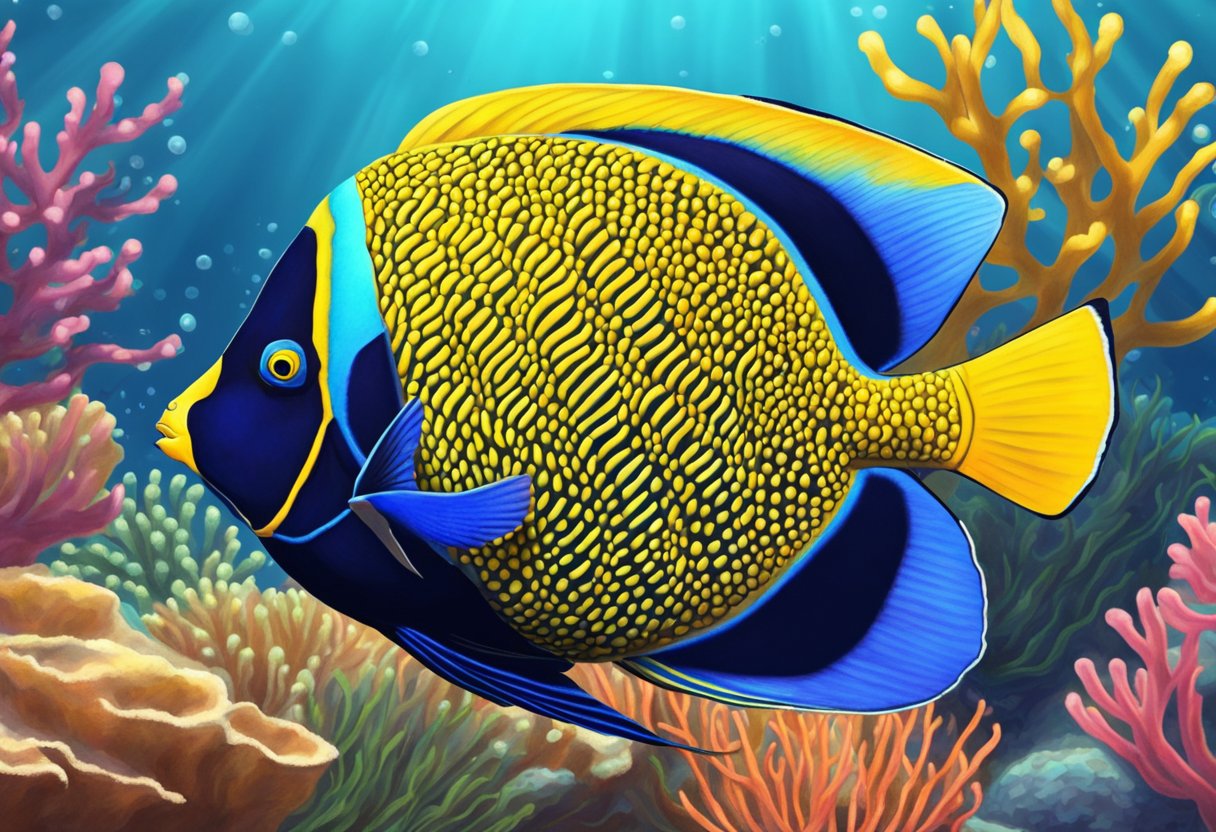
When considering the Koran Angelfish for an aquarium, we must pay close attention to their behavior and compatibility with other fish. In our experience, the nuances of their social interactions and careful selection of tank mates are crucial to maintaining harmony in a marine environment.
Social Behavior
The Koran Angelfish exhibits a semi-aggressive temperament, often showcasing territorial attitudes towards other angelfish and similar-shaped fish. As juveniles, they tend to be more docile, but as they mature, their dominance in the tank becomes more evident. Males can be particularly assertive, especially during breeding times when they are guarding their territory.
- Temperament: Semi-aggressive
- Territory: Protective of space, especially in adulthood
- Breeding Behaviors: Increased aggression from males
Suitable Tank Mates
Choosing suitable tank mates for the Koran Angelfish involves a careful balance to prevent aggressive interactions. Gobies, wrasses, and clownfish are generally deemed compatible due to differing shapes and habits, which helps reduce territorial disputes. It is recommended to avoid similar-shaped fish or other angelfish that could trigger the Koran Angelfish’s aggressive tendencies.
Compatible:
- Gobies: Peaceful; steer clear of angelfish territory.
- Wrasses: Active swimmers; usually not a threat to angelfish territory.
- Clownfish: Small and non-competitive for space.
To Avoid:
- Similar shaped species
- Other angelfish
We must introduce tank mates in a manner that minimizes territorial disputes, ensuring that the aquarium is spacious enough to allow each species its required territory. This plan enhances the likelihood of a peaceful coexistence.
Breeding and Reproduction
In our examination of Koran Angelfish breeding and reproduction, we observe distinct behaviors and methods that facilitate their propagation in marine environments. These processes are critical for maintaining their populations within reef ecosystems.
Mating Rituals
Koran Angelfish (Pomacanthus semicirculatus), similar to their cousins such as the Emperor Angelfish and French Angelfish, exhibit specific rituals when it is time to reproduce. The male and female perform an elaborate dance which includes swimming in unison towards the water’s surface. This behavior usually occurs around dusk.
- Initiation: The male displays vibrant colors to attract a mate.
- Courtship: Sequential swimming patterns ensue, with both male and female engaging in a ritualistic display.
- Spawning: Release of gametes occurs simultaneously as they ascend, ensuring fertilization in the open water.
Rearing Offspring
Once the eggs are fertilized, they become part of the planktonic community, where they must survive without parental care.
- Egg to Larvae: The eggs hatch within 15-20 hours, and the larvae remain planktonic for several weeks.
- Survival: Juvenile Koran Angelfish are predominantly independent and face predation; they must find refuge among corals and sponges.
- Diet: The larvae feed on zooplankton while gradually adapting to include clams and various sponge species.
Their growth from larvae to mature Koran Angelfish is marked by a series of morphological changes that prepare them for the vibrant reef life where they will establish their own territories.
Frequently Asked Questions
In this section, we answer some of the most common inquiries about keeping Koran Angelfish in a home aquarium.
What are suitable tank mates for the Koran Angelfish?
Koran Angelfish thrive with peaceful fish that can hold their own, such as larger clownfish, tangs, and wrasses. It is important to avoid housing them with overly aggressive species or small, docile fish that they might bully.
How quickly do Koran Angelfish grow?
Under optimal conditions, Koran Angelfish can grow rapidly, reaching a full adult size of up to 15 inches within a couple of years. Regular feeding and proper tank maintenance are key to their growth rate.
What is the minimum aquarium size needed for a Koran Angelfish?
A Koran Angelfish requires a tank of at least 125 gallons to accommodate its size and active swimming behavior. This space allows the fish to thrive and exhibit natural behaviors.
How does one properly care for a Koran Angelfish in a home aquarium?
Proper care for a Koran Angelfish includes maintaining high water quality with regular water changes, providing a varied diet rich in marine algae and meaty foods, and ensuring plenty of live rock for grazing and hiding.
At what size are Koran Angelfish typically sold?
Koran Angelfish are usually sold when they are juvenile to young adults, typically ranging from 2 to 4 inches in length. This size is more manageable for most aquariums and allows the fish to acclimate to their new environment.
Are juvenile Koran Angelfish more adaptable to reef aquariums than adults?
Juvenile Koran Angelfish tend to be more adaptable to reef aquariums and are less likely to nibble on corals and clams than adults. However, caution is advised, as individual behavior can vary.
